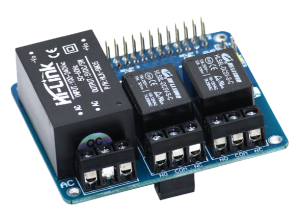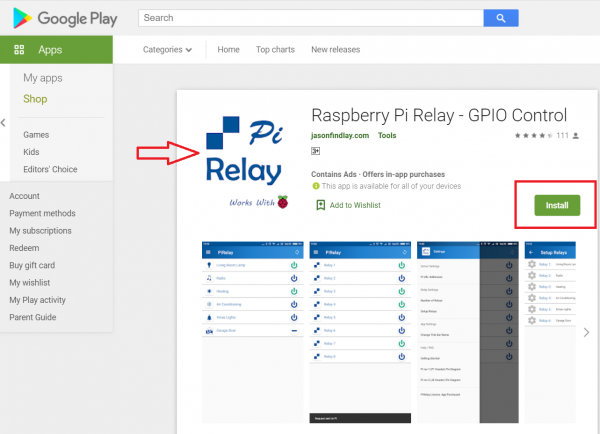Difference between revisions of "Home-Automation-HAT"
From SB-Components Wiki
| Line 59: | Line 59: | ||
[[File:PiRelay-APP.PNG | 600px]] | [[File:PiRelay-APP.PNG | 600px]] | ||
| − | * Make sure your Pi and Android Device are on the same network. Then in the app settings, you can define a custom Server URL. This is the network path to your Raspberry Pi. The default path is " http://raspberrypi/ ", however, you can define an IP address or a custom URL. | + | * Make sure your Pi and Android Device are on the same network. Then in the app settings, you can define a custom Server URL. This is the network path to your Raspberry Pi. The default path is " http://raspberrypi/ ", however, you can define an IP address or a custom URL. To setup communication with your Raspberry Pi, click on '''≡ >> Pi URL Addresses''', then set Pi 1 : Your Pi IP Address (for eg: http://192.168.1.14) |
* To turn on/off relays, Use Pins as Wiring Pi pinout shown above in Pinout table. | * To turn on/off relays, Use Pins as Wiring Pi pinout shown above in Pinout table. | ||
| − | |||
* To setup Relays, Click on '''≡ >> Number of Relays''', and set it to 2. | * To setup Relays, Click on '''≡ >> Number of Relays''', and set it to 2. | ||
* Now again click on '''≡ >> Setup Relays''', Now click on any relay and set WiringPi Pin for '''Relay 1 as 24''', and '''Relay 2 as 23'''. You can also set Relay default status here. | * Now again click on '''≡ >> Setup Relays''', Now click on any relay and set WiringPi Pin for '''Relay 1 as 24''', and '''Relay 2 as 23'''. You can also set Relay default status here. | ||
Revision as of 08:55, 29 September 2021
Home Automation HAT
Home Automation HAT is a Home monitoring and automation controller HAT for the Raspberry Pi that can control up to 2 appliances/devices on a load of 250 VAC/7A, 30 VDC/10A, photo-coupling isolation Optocoupler EL357NC, allowing users to safely control high voltages or current devices. Home-Automation HAT makes appliances smart, which users can operate via the PiRelay app on their electronic device.
Features
- Compatible with Raspberry Pi 4, 3B+,3,2,Zero
- Relay Status Indicator
- Comes With Development Resources, including examples in Python
- COM, NO(Normally Open) & NC(Normally Closed) are available for each relay
- Connectivity of Relay With RPi Without GPIO
- Connectivity Using Stack Method
- Onboard Power LED Indicator
- Make Your Home IoT Enabled
- Relay Control Pins Selection Jumper
Specifications
- Operating Voltage - 220V AC (Via Terminal Block)
- External Load - 250 VAC/7A, 30 VDC/10A
- Relay Channels - 2
- Trigger Signal - 3.3/5V
- Optocoupler - (CTR: 50~600% at IF= 5mA, VCE = 5V)
- External Power Supply - Via Terminal Block
- GPIO - 40 Pins Stacking Header
- Load Connector - Screw Terminal Block for each Relay(Output)

Pinout
| Relays | BOARD | BCM | Wiring Pi |
|---|---|---|---|
| Relay 1 | 35 | GPIO 19 | 24 |
| Relay 2 | 33 | GPIO 13 | 23 |
Installation
Raspberry Pi (Using PiRelay App)
PiRelay is an Android app you can use to Switch or Pulse the GPIO Pins of a Raspberry Pi connected to Relays. To use this app you will need to setup your Raspberry Pi and Relays. App Download link: https://play.google.com/store/apps/details?id=com.jasonfindlay.pirelaypro
- To setup PiRelay on Raspberry Pi, run the below commands one by one. Must complete all commands to make it work with Raspberry Pi.
Commands to Install: WiringPi, Apache, PHP & Download the GPIO PHP File
sudo apt-get update
sudo apt-get install wiringpi apache2 libapache2-mod-php -y
sudo wget https://pirelay.jasonfindlay.com/downloads/gpio.dl
sudo mv gpio.dl /var/www/html/gpio.php
Setting Up Your Android Device
- Download Pi Relay app from the Play Store here: PiRelay App Download
- Make sure your Pi and Android Device are on the same network. Then in the app settings, you can define a custom Server URL. This is the network path to your Raspberry Pi. The default path is " http://raspberrypi/ ", however, you can define an IP address or a custom URL. To setup communication with your Raspberry Pi, click on ≡ >> Pi URL Addresses, then set Pi 1 : Your Pi IP Address (for eg: http://192.168.1.14)
- To turn on/off relays, Use Pins as Wiring Pi pinout shown above in Pinout table.
- To setup Relays, Click on ≡ >> Number of Relays, and set it to 2.
- Now again click on ≡ >> Setup Relays, Now click on any relay and set WiringPi Pin for Relay 1 as 24, and Relay 2 as 23. You can also set Relay default status here.
- Now move back to the home screen and click on On/Off button to turn on/off relays.
Resources
Github

